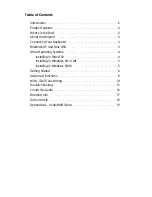
(Note that each time the keyboard is turned off the data assigned to the
Modulation Wheel will be lost. Each time the keyboard is powered up, the
modulation Wheel will default to being assigned to Modulation, effect number 01.)
As an example, let’s assign effect number 10 to the modulation wheel. This
means the modulation wheel will control the Pan (or balance). To do this, we
need to:
Press the Advanced Functions button to get the keyboard into Edit Mode.
Press the Black Key above C4 (named C# 4), representing “WHEEL ASSIGN.”
Press A3 to enter “1.”
Press G3 to enter “0” so you have entered “10.”
Press C5 for “ENTER.”
The Volume Slider
As with the Modulation Wheel, the Volume Slider can be assigned to any of the
131 effects shown at the back of this manual.
To assign the Volume Slider to an effect:
Press the Advanced Functions button to get the keyboard into Edit Mode.
Press the Black Key above D4 (named D# 4), representing “SLIDER ASSIGN.”
Use the Numerical Data Entry keys G3 – B4 to enter the number of the
effect you want to assign to the Volume Slider.
Alternatively, you can use the “+” and “-” buttons to change the value.
Press the ENTER key (C5).
Move the Volume Slider upwards to increase the value of the effect.
If you make an error while entering the numerical data value, you can press
the CANCEL key (C1) to exit Edit Mode without changing the effect assigned to
the Volume Slider.
(Note that each time the keyboard is turned off, the data assigned to the
Volume Slider will be lost. Each time the keyboard is powered up, the Volume
Slider will default to being assigned to Volume, effect number 07.)
Pitchbend Sensitivity
It is possible to alter the sensitivity of the Pitchbend wheel by assigning effect
number 128 to the Modulation Wheel or Volume Slider. This will allow you to
alter the pitchbend range up to one octave up and down.
13




















